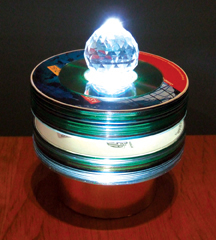
Where the Rubber Meets the Road
Some "Alternative" Uses for ASTM International Standards
With standards in use in almost every nation on earth, there can be no doubt as to their importance for global trade and consumer safety. But as anyone who has used a screwdriver as a chisel can attest, the real value of the tool is revealed when used spontaneously for unintended purposes to solve a problem.
How do ASTM International standards perform in the real world when used extemporaneously?
Ergonomics
Ergonomics is the study of the design and arrangement of equipment so that people interact with it in a healthy, comfortable and efficient way. In the office environment, ergonomics concerns factors such as the physical design and placement of keyboards, screens and other devices in a way that reduces operator fatigue and discomfort as well as the potential for repetitive strain and other injuries.
To that end, an ergonomic review of office workstations can only enhance productivity. By evaluating each employee's working position for correct posture and line of sight, tasks can be completed more efficiently and comfortably.
There can be equipment limitations, however. For someone taller than average, for example, support stands for computer monitors may be just a bit too low for the correct line of sight. ASTM International to the rescue. The 2004 Annual Book of ASTM Standards, Section Two, Vol. 02.04 on Nonferrous Metals, can provide just the needed boost in screen height. Committee E34 on Occupational Health and Safety, take note!
Sports Equipment
One of the joys of winter is shinny hockey on outdoor ice. This is a game played in countless Canadian neighborhoods between players of all ages needing only skates and a hockey stick. With little or no protective equipment worn, the rules are kept simple - the puck has to stay on the ice. But sometimes overzealous playing results in shins hit by flying pucks or sticks. Ouch.
To avoid the possibility of lower leg injuries, some players now show up at the rink with lightweight modern padding. For those not wanting to incur the expense, or too pococurante to be embarrassed by fashion faux pas, there is always the possibility of following the advice of old-timers who used to stuff phone books into their socks as shin guards. This unconventional approach may not be covered by ASTM Committee F08 on Sports Equipment and Facilities, but it is quite effective. Since in some cities the phone book is so thick that it makes skating difficult, the 1999 Annual Book of ASTM Standards, Section One, Vol. 01.06 for Coated Steel Products, works just fine.
Digital Standards
Standards and standardization are continuously evolving with the growing needs of customers and the ever-increasing amount of knowledge and information available in the global marketplace, and ASTM International is keeping pace. Printed volumes of standards are giving way to digital media in the form of compact discs. However, after several years of committee membership and participation on various committees, the discs begin to pile up. What can be done with these when the new versions come out?
With a cradle-to-cradle philosophy, used products become raw materials for new products. While reducing the consumption of raw materials is good, the reuse of manufactured products is even better.
One way to reuse old CDs is for lighting products. With a stack of old ASTM standards on disc, a decorative support system and a modern light source, you can use a collection of superseded ASTM CDs to create mood lighting to rival the lava lamp. Members of ASTM Committee E60 on Sustainability would be proud.
Standards must be flexible and versatile in order to meet the changing needs of customers, no matter what the context or application. As these three examples have shown, ASTM International standards and delivery methods provide users with the ultimate flexibility to solve problems and provide customer satisfaction.
Martin Gagné is manager of product development for Xstrata Zinc Canada, Toronto, Ontario, investigating new zinc products for coatings, castings and energy applications. He is a member of ASTM International Committees A05 on Metallic-Coated Iron and Steel Products, B02 on Nonferrous Metals and Alloys, and E60 on Sustainability. In his spare time Gagné volunteers as a youth mentor with Big Brothers and Big Sisters of Toronto.
José Maldonado is an 11th-grade student at the Royal St. George's College High School in Toronto, Ontario, Canada. Maldonado is also a youth leader at the Yonge Street Mission and has been in the Big Brothers program since 2001. His extracurricular activities include singing in the school choir and he is the Puppet King of the school gamers union.
Gagné reports that the idea for this article developed while educating Maldonado about the benefits of standards.
 SN Home
SN Home Archive
Archive Advertisers
Advertisers Masthead
Masthead RateCard
RateCard Subscribe
Subscribe Email Editor
Email Editor